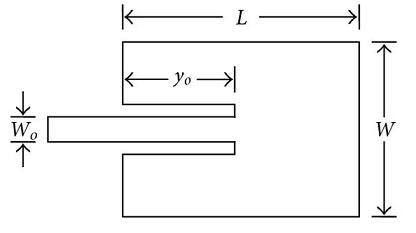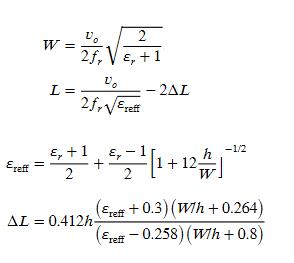A microstrip antenna can be designed using either the transmission line model or the cavity model (more complex models also exist that suit a particular design). We here demonstrate the transmission line model since it is fairly simple to implement and results in antenna designs with reasonably good performance in terms of return loss and efficiency.

The design starts with selecting the operating frequency, selecting a substrate with the required permittivity, and defining the width of the substrate. Thick substrates with low permittivity result in antenna designs with high efficiency and large bandwidths. Thin substrates with high permittivity lead to a smaller antenna size but with a lower bandwidth and a high-radiation loss. The tradeoffs between substrate thickness and permittivity and antenna bandwidth and efficiency have been discussed in the literature.
According to the transmission line model, the length L and width W of the patch are calculated as
Although the design of the patch is quite simple, the design of the feeding mechanism is not that straightforward. There are four possible methods that can be used:
(1) Microstrip-line feed
(2) Probe feed
(3) Aperture-coupled feed
(4) Proximity-coupled feed
Reference
[1] Yasir Ahmed, Yang Hao, and Clive Parini, “A 31.5 GHz Patch Antenna Design for Medical Implants,” International Journal of Antennas and Propagation, vol. 2008, Article ID 167980, 6 pages, 2008.
Author: Yasir Ahmed (aka John)
More than 20 years of experience in various organizations in Pakistan, the USA, and Europe. Worked as a Research Assistant within the Mobile and Portable Radio Group (MPRG) of Virginia Tech and was one of the first researchers to propose Space Time Block Codes for eight transmit antennas. The collaboration with MPRG continued even after graduating with an MSEE degree and has resulted in 12 research publications and a book on Wireless Communications. Worked for Qualcomm USA as an Engineer with the key role of performance and conformance testing of UMTS modems. Qualcomm is the inventor of CDMA technology and owns patents critical to the 4G and 5G standards.
